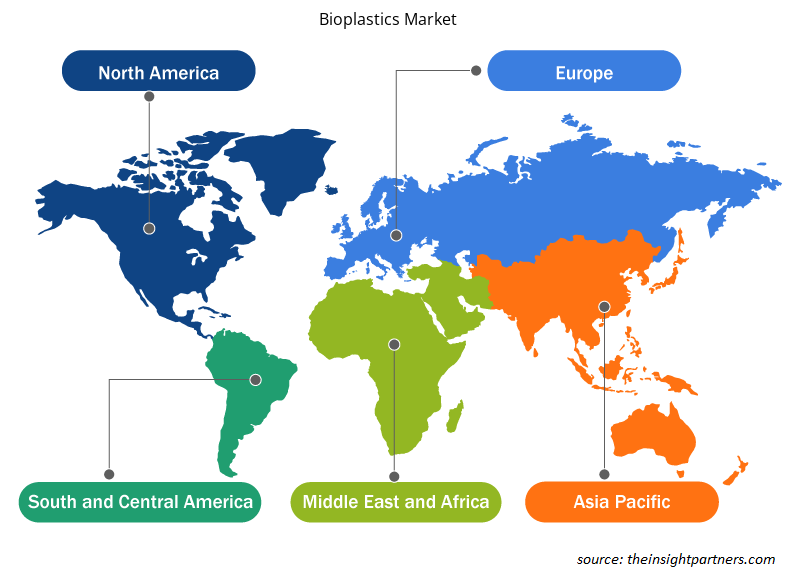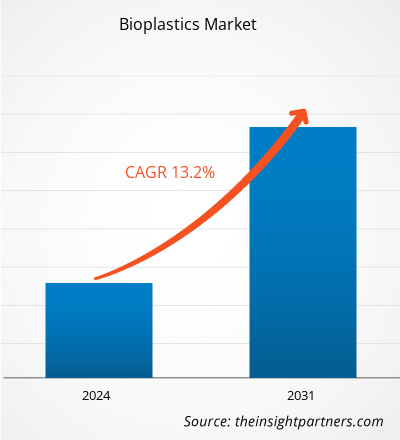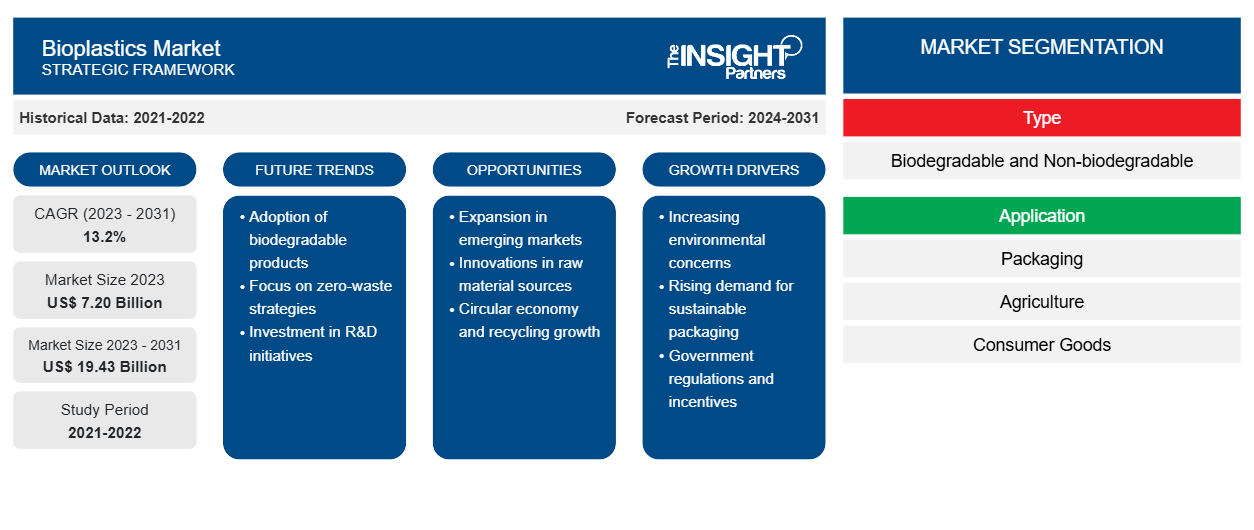من المتوقع أن يصل حجم سوق البلاستيك الحيوي إلى 19.43 مليار دولار أمريكي بحلول عام 2031 من 7.20 مليار دولار أمريكي في عام 2023. ومن المتوقع أن يسجل السوق معدل نمو سنوي مركب بنسبة 13.2٪ في الفترة 2023-2031. ومن المرجح أن يظل التركيز المتزايد على الابتكار والتقدم التكنولوجي من الاتجاهات الرئيسية لسوق البلاستيك الحيوي.
تحليل سوق البلاستيك الحيوي
إن المخاوف البيئية المتزايدة والجهود العالمية للحد من التلوث تدفع الطلب على البلاستيك القابل للتحلل الحيوي في قطاع التعبئة والتغليف في جميع أنحاء العالم. بالإضافة إلى ذلك، من المتوقع أن ينمو الطلب على البلاستيك الحيوي في صناعة التعبئة والتغليف بسبب الحاجة المتزايدة لمنتجات الرعاية الصحية المختلفة. علاوة على ذلك، من السهل على الشركات المصنعة تصنيع عبوات بلاستيكية حيوية لأن العبوات المنتجة من البوليمرات الحيوية يمكن إنتاجها عادةً باستخدام تقنية معالجة البلاستيك القياسية. الطلب المتزايد على البلاستيك الصديق للبيئة في قطاع التعبئة والتغليف هو عامل رئيسي من المتوقع أن يعزز نمو سوق البلاستيك الحيوي في جميع أنحاء العالم خلال فترة التنبؤ.
نظرة عامة على سوق البلاستيك الحيوي
البلاستيك الحيوي عبارة عن مواد بلاستيكية مكونة من مصادر الكتلة الحيوية المتجددة، والتي تشمل الدهون والزيوت النباتية، ونشا الذرة، والقش، ورقائق الخشب، ونشارة الخشب، ونفايات الطعام المعاد تدويرها، وغيرها. يتم استخدام البلاستيك الحيوي بشكل متزايد للحد من مشكلة النفايات البلاستيكية التي تخنق الكوكب وتلوث البيئة ؛ إلى جانب ذلك، يتطلب إنتاج البلاستيك الحيوي طاقة أقل بنسبة 65٪ من البلاستيك البترولي التقليدي.
قم بتخصيص هذا التقرير ليناسب متطلباتك
ستحصل على تخصيص لأي تقرير - مجانًا - بما في ذلك أجزاء من هذا التقرير، أو تحليل على مستوى الدولة، وحزمة بيانات Excel، بالإضافة إلى الاستفادة من العروض والخصومات الرائعة للشركات الناشئة والجامعات
-
احصل على أهم اتجاهات السوق الرئيسية لهذا التقرير.ستتضمن هذه العينة المجانية تحليلاً للبيانات، بدءًا من اتجاهات السوق وحتى التقديرات والتوقعات.
محركات وفرص سوق البلاستيك الحيوي
ارتفاع الطلب على البلاستيك الحيوي في مجالات التطبيق المختلفة
الطلب المتزايد على البلاستيك الحيوي في مجالات التطبيق المختلفة هو محرك مهم لسوق البلاستيك الحيوي. يتم استخدام البلاستيك الحيوي في العديد من الصناعات النهائية مثل الطب والسيارات والنقل والتعبئة والتغليف والزراعة والسلع الاستهلاكية والمنسوجات والبناء والتشييد وغيرها. في القطاع الطبي، للبلاستيك الحيوي تطبيقات شاملة في إدارة الجروح وهندسة الأنسجة وتوصيل الأدوية والأجهزة التقويمية وتصنيع السقالات الليفية والمسامية. في قطاع السيارات، يوفر البلاستيك الحيوي اعتمادًا أقل على الموارد الأحفورية، وانخفاضًا في تكلفة التصنيع، وتقليلًا كبيرًا في البصمة الكربونية. علاوة على ذلك، يتم استخدام البلاستيك الحيوي في التغليف الصلب لمستحضرات التجميل من المساحيق المضغوطة والكريمات وأحمر الشفاه وزجاجات المشروبات .
قوانين وأنظمة حكومية صارمة بشأن استخدام البلاستيك التقليدي
لقد طبقت العديد من الدول في جميع أنحاء العالم قوانين ولوائح تتعلق بالبلاستيك. وتبذل العديد من الدول جهودًا لحظر البلاستيك الذي يستخدم لمرة واحدة وتعزيز البدائل المستدامة له. وسيساعد هذا في تخفيف الآثار الضارة على حياة الإنسان والبيئة. وبالتالي، من المتوقع أن توفر القوانين واللوائح الحكومية الصارمة بشأن استخدام البلاستيك التقليدي فرصًا أكثر ربحية لنمو سوق البلاستيك الحيوي.
تقرير تحليل تجزئة سوق البلاستيك الحيوي
إن القطاعات الرئيسية التي ساهمت في استخلاص تحليل سوق البلاستيك الحيوي هي النوع والتطبيق.
- بناءً على النوع، يتم تقسيم السوق إلى قابل للتحلل وغير قابل للتحلل. احتلت شريحة المواد القابلة للتحلل حصة سوقية أكبر في عام 2023.
- من حيث التطبيق، يتم تقسيم السوق إلى التعبئة والتغليف والزراعة والسلع الاستهلاكية والسيارات والنقل والمنسوجات والبناء والتشييد وغيرها. احتل قطاع التعبئة والتغليف الحصة الأكبر من السوق في عام 2023.
تحليل حصة سوق البلاستيك الحيوي حسب المنطقة الجغرافية
ينقسم النطاق الجغرافي لتقرير سوق البلاستيك الحيوي بشكل أساسي إلى خمس مناطق: أمريكا الشمالية، ومنطقة آسيا والمحيط الهادئ، وأوروبا، والشرق الأوسط وأفريقيا، وأمريكا الجنوبية والوسطى.
كانت منطقة آسيا والمحيط الهادئ تهيمن على السوق العالمية. وتعد أوروبا ثاني أكبر مساهم في حصة سوق البلاستيك الحيوي العالمية. وفي أمريكا الشمالية، يتم استهلاك البلاستيك الحيوي على نطاق واسع في قطاع التعبئة والتغليف في شكل زجاجات وأكياس بلاستيكية. ومن المتوقع أن ينمو إنتاج واستهلاك البلاستيك الحيوي في المنطقة، وخاصة في تطبيقات تغليف المواد الغذائية. وعلى عكس البلاستيك التقليدي، يتم الحصول على البلاستيك الحيوي من مصادر متجددة. تعد صناعة السيارات في هذه المنطقة واحدة من أكثر الصناعات تقدمًا على مستوى العالم بسبب الاستثمارات الكبيرة في البنية التحتية وأنشطة البحث والتطوير ومرافق الإنتاج الجديدة. تعد البولي أميدات الحيوية (Bio-PA) وحمض البوليكتيك (PLA) والبولي بروبيلين الحيوي (Bio-PP) من البلاستيك الحيوي المستخدم على نطاق واسع في تصنيع السيارات. هذه العوامل تدفع نمو سوق البلاستيك الحيوي للسيارات.
رؤى إقليمية حول سوق البلاستيك الحيوي
لقد قام المحللون في Insight Partners بشرح الاتجاهات والعوامل الإقليمية المؤثرة على سوق البلاستيك الحيوي طوال فترة التوقعات بشكل شامل. يناقش هذا القسم أيضًا قطاعات سوق البلاستيك الحيوي والجغرافيا في جميع أنحاء أمريكا الشمالية وأوروبا ومنطقة آسيا والمحيط الهادئ والشرق الأوسط وأفريقيا وأمريكا الجنوبية والوسطى.

- احصل على البيانات الإقليمية المحددة لسوق البلاستيك الحيوي
نطاق تقرير سوق البلاستيك الحيوي
| سمة التقرير | تفاصيل |
|---|---|
| حجم السوق في عام 2023 | 7.20 مليار دولار أمريكي |
| حجم السوق بحلول عام 2031 | 19.43 مليار دولار أمريكي |
| معدل النمو السنوي المركب العالمي (2023 - 2031) | 13.2% |
| البيانات التاريخية | 2021-2022 |
| فترة التنبؤ | 2024-2031 |
| القطاعات المغطاة |
حسب النوع
|
| المناطق والدول المغطاة |
أمريكا الشمالية
|
| قادة السوق وملفات تعريف الشركات الرئيسية |
|
كثافة اللاعبين في سوق البلاستيك الحيوي: فهم تأثيرها على ديناميكيات الأعمال
يشهد سوق البلاستيك الحيوي نموًا سريعًا، مدفوعًا بالطلب المتزايد من المستخدم النهائي بسبب عوامل مثل تفضيلات المستهلكين المتطورة والتقدم التكنولوجي والوعي المتزايد بفوائد المنتج. ومع ارتفاع الطلب، تعمل الشركات على توسيع عروضها والابتكار لتلبية احتياجات المستهلكين والاستفادة من الاتجاهات الناشئة، مما يؤدي إلى زيادة نمو السوق.
تشير كثافة اللاعبين في السوق إلى توزيع الشركات أو المؤسسات العاملة في سوق أو صناعة معينة. وهي تشير إلى عدد المنافسين (اللاعبين في السوق) الموجودين في مساحة سوق معينة نسبة إلى حجمها أو قيمتها السوقية الإجمالية.
الشركات الرئيسية العاملة في سوق البلاستيك الحيوي هي:
- شركة تيجين المحدودة
- شركة توراي للصناعات المحدودة
- سابك
- باسف اس اي
- إجمالي كوربيون PLA
- شركة براسكيم
إخلاء المسؤولية : الشركات المذكورة أعلاه ليست مرتبة بأي ترتيب معين.

- احصل على نظرة عامة على أهم اللاعبين الرئيسيين في سوق البلاستيك الحيوي
أخبار سوق البلاستيك الحيوي والتطورات الأخيرة
يتم تقييم سوق البلاستيك الحيوي من خلال جمع البيانات النوعية والكمية بعد البحث الأولي والثانوي، والتي تتضمن منشورات الشركات المهمة وبيانات الجمعيات وقواعد البيانات. فيما يلي قائمة بالتطورات في سوق اضطرابات الكلام واللغة والاستراتيجيات:
- أطلقت شركة سابك، الشركة الرائدة عالميًا في صناعة الكيماويات، اليوم مجموعة جديدة من راتنجات ULTEM™ القائمة على المواد الحيوية والتي توفر فوائد الاستدامة مع تقديم نفس الأداء العالي وقابلية المعالجة مثل مواد ULTEM الحالية. تعد مواد البولي إيثيريميد (PEI) الرائدة هذه أول بوليمرات متجددة عالية الأداء وغير متبلورة معتمدة متاحة في الصناعة. (المصدر: سابك، الأخبار والإعلام/آخر الأخبار/أكتوبر 2021)
- أعلنت شركة Toray Industries, Inc. اليوم أنها طورت ألياف نايلون 510 (N510) تحتوي على 100% من "محتوى البوليمر الاصطناعي الحيوي" كما هو محدد في القسم 3.1.5 من ISO 16620-1: 2015، المعيار الدولي لمحتوى البلاستيك الحيوي. ستكون Ecodear N510 أول ألياف نايلون نباتية 100% في مجموعة Ecodear من Toray. (المصدر: TORAY INDUSTRIES, INC.، غرفة الأخبار/ يناير 2022)
تغطية تقرير سوق البلاستيك الحيوي والمنتجات النهائية
يوفر تقرير "حجم سوق البلاستيك الحيوي والتوقعات (2021-2031)" تحليلاً مفصلاً للسوق يغطي المجالات التالية:
- حجم السوق والتوقعات على المستويات العالمية والإقليمية والوطنية لجميع قطاعات السوق الرئيسية التي يغطيها النطاق
- ديناميكيات السوق مثل المحركات والقيود والفرص الرئيسية
- الاتجاهات المستقبلية الرئيسية
- تحليل مفصل لقوى بورتر الخمس ونقاط القوة والضعف والفرص والتهديدات
- تحليل السوق العالمي والإقليمي الذي يغطي اتجاهات السوق الرئيسية واللاعبين الرئيسيين واللوائح والتطورات الأخيرة في السوق
- تحليل المشهد الصناعي والمنافسة الذي يغطي تركيز السوق، وتحليل خريطة الحرارة، واللاعبين البارزين، والتطورات الأخيرة
- ملفات تعريف الشركة التفصيلية
- التحليل التاريخي (سنتان)، سنة الأساس، التوقعات (7 سنوات) مع معدل النمو السنوي المركب
- تحليل PEST و SWOT
- حجم السوق والقيمة / الحجم - عالمي، إقليمي، بلد
- الصناعة والمنافسة
- مجموعة بيانات إكسل
التقارير الحديثة
تقارير ذات صلة
شهادات العملاء
سبب الشراء
- اتخاذ قرارات مدروسة
- فهم ديناميكيات السوق
- تحليل المنافسة
- رؤى العملاء
- توقعات السوق
- تخفيف المخاطر
- التخطيط الاستراتيجي
- مبررات الاستثمار
- تحديد الأسواق الناشئة
- تحسين استراتيجيات التسويق
- تعزيز الكفاءة التشغيلية
- مواكبة التوجهات التنظيمية























 احصل على عينة مجانية ل - سوق البلاستيك الحيوي
احصل على عينة مجانية ل - سوق البلاستيك الحيوي